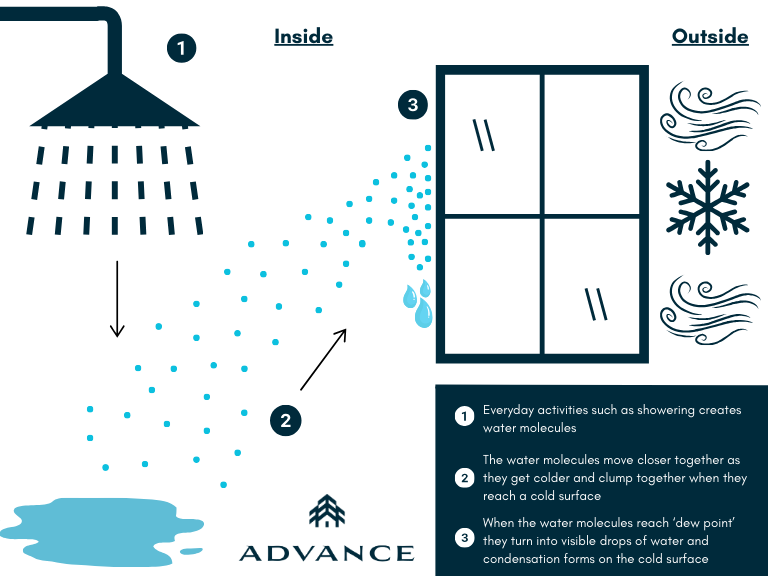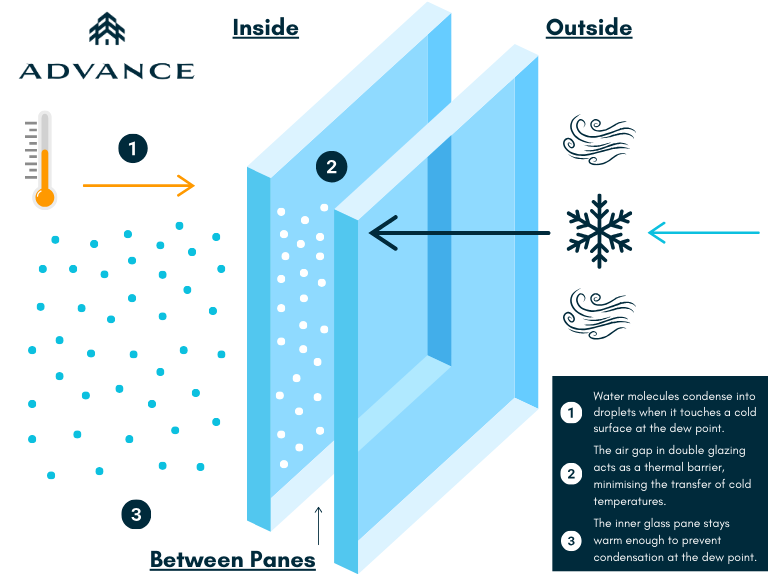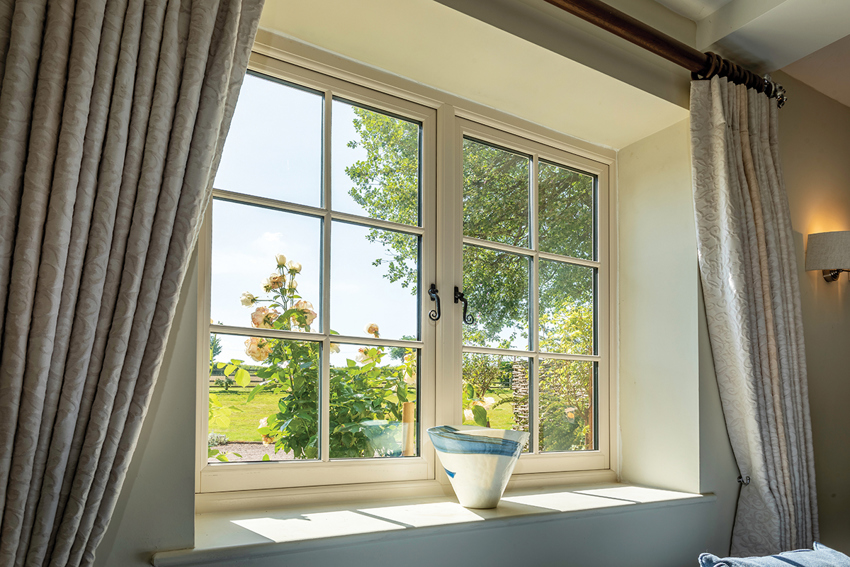uPVC Windows vs Aluminium Windows
One of the most common decisions homeowners face is whether to go for uPVC windows or aluminium windows. In this article, we take a look at uPVC windows and aluminium windows and which could be the best choice.
Are you surprised to see water droplets forming on your brand-new windows? While condensation can be a normal reaction to environmental conditions, it may also signal something worth addressing. In this blog, we’ll help you understand the causes of window condensation, determine when it’s harmless versus when it requires attention, and explore effective solutions to keep your windows clear and your home comfortable. Read on to learn how to protect your investment and maintain the efficiency of your new windows.

Condensation is the process where water vapor in the air converts into liquid water upon contact with a cooler surface, such as window glass. It’s a natural phenomenon caused by the difference between indoor and outdoor temperatures. This is most common in winter when warm indoor air meets cold window surfaces, but it can also happen in summer with air-conditioned homes. Other common causes of condensation are everyday activities such as cooking, showering, and drying clothes (which add moisture to the air inside your home), and poor ventilation.

If you’ve recently installed new windows, you might be surprised to notice condensation forming. Here’s why this happens:
Better Insulation: New, energy-efficient windows are designed to be airtight, which can trap more moisture inside your home. Older windows often allowed for more airflow, unintentionally helping reduce indoor humidity levels.
Improved Temperature Differences: Double or triple glazed windows keep the indoor surface of the glass warmer, reducing condensation in many cases. However, the enhanced insulation can also exaggerate humidity imbalances, leading to temporary condensation as your home adjusts to its improved thermal efficiency.
Adjusting to New Conditions: Post-installation, your home may experience a short period of acclimatisation, during which indoor humidity levels stabilise. This can sometimes lead to noticeable condensation on your new windows.

Condensation, in certain situations, is a natural and harmless occurrence that doesn't indicate a problem with your windows or your home's environment. If the condensation clears up quickly as temperatures stabilise or airflow improves, or there's a slight fogging during extremely cold mornings, especially in older homes, there’s usually no cause for concern.
Let’s explore two key scenarios where condensation is typically not a cause for concern:
Exterior Condensation:
Exterior condensation occurs when the outer surface of your windows cools below the dew point of the air outside. This is especially common during summer mornings or in humid climates. Exterior condensation is actually a sign of highly efficient, well-insulated windows. The panes prevent the transfer of indoor heat to the outside, keeping the outer surface cooler.
Interior Condensation:
Interior condensation is when moisture collects on the inside surface of windows. It’s common under specific conditions and generally harmless if it occurs temporarily. Cold weather and everyday activities such as boiling water and breathing contribute to the humidity.
Why These Types of Condensation Are Harmless:

While condensation on windows is often harmless, certain situations suggest underlying problems that may require attention. Persistent or problematic condensation can impact your home’s structure, energy efficiency, and indoor air quality. Here’s a closer look at when condensation becomes a concern:
Persistent Interior Condensation
If you consistently notice moisture on the inside of your windows, it may be a sign of an issue within your home. Persistent interior condensation can lead to mould growth, wood rot and peeling paint or warping.
Condensation Between Panes
Condensation trapped between double- or triple-pane windows is a clear sign of a failed seal. The seal is responsible for keeping insulating gas (like argon or krypton) between the panes to enhance energy efficiency. When the seal is broken, the gas escapes, and the window’s insulating properties are compromised. This can result in: reduced energy efficiency, foggy or hazy windows and risk of further deterioration.
If you have condensation between your window panes and your windows are still covered by warranty, it is highly recommended that you contact the window manufacturer or installer for repair or replacement. However, if you're no longer covered by warranty then you should seriously consider replacing the glass unit or the entire window for improved energy efficiency and aesthetics.
Frost or Ice Formation
The presence of frost or ice on the interior of your windows, particularly during winter, is a sign of excessive indoor humidity combined with poor insulation. This is worrisome as it means your windows are unable to maintain a thermal barrier between the cold outside air and the warm interior, contributing to heat loss and prolonged frost or ice buildup can damage window seals, frames, and nearby structures.
Health Risks from Mould and Mildew
One of the primary concerns with condensation is its potential to promote mould and mildew growth. Mould thrives in damp, humid environments, and condensation provides the perfect breeding ground. Prolonged exposure to mould can significantly impact your health, particularly for vulnerable individuals with respiratory issues, skin irritation or with weakened immune systems.
According to the Centers for Disease Control and Prevention (CDC), long-term exposure to mould can also aggravate chronic respiratory conditions, making it crucial to address condensation and moisture problems as soon as they arise.
How Condensation Damages Your Windows
While condensation itself might seem harmless, if left unchecked, it can cause significant damage to your windows and surrounding structures.

Condensation can cause significant issues if not managed properly, but there are several ways to reduce or eliminate it. From improving ventilation to choosing the right windows, here are some practical steps to stop condensation from forming, reduce it between window frames, and maintain a healthy and energy-efficient home.
How to Stop Condensation from Forming
Condensation occurs when warm, moist air meets a cold surface, but you can prevent or reduce it with these strategies:
Improve Ventilation to Reduce Condensation
Proper ventilation is crucial in preventing condensation. Without it, moisture becomes trapped in the air, leading to condensation on windows, walls, and other surfaces. Here’s how to improve ventilation in your home:

How Double Glazing Reduces Condensation
Double glazing is one of the most effective solutions for reducing condensation on windows. Here’s how it works:
Condensation on windows, while a common occurrence, can often be more than just an inconvenience. While some level of condensation is normal, especially in colder months or in homes with improved insulation, persistent or problematic condensation can lead to serious issues. From health concerns like mould and mildew growth to damage to your windows and surrounding structures, it’s important to recognise when condensation becomes a problem.
By understanding the causes of condensation - such as temperature differences, poor ventilation, and high humidity levels - you can take the necessary steps to prevent it. Simple solutions like using dehumidifiers, improving ventilation, and opting for double-glazed windows can make a significant difference. In cases where condensation signals a failed window seal or persistent moisture buildup, it's crucial to address the problem promptly to avoid costly repairs and health risks.
Taking proactive measures to manage condensation not only helps maintain the integrity of your windows but also ensures a healthier and more comfortable living environment. So, whether you're dealing with new windows or an older home, staying ahead of condensation issues will help you preserve your home’s condition and protect your well-being.

In need of some new windows? Contact Advance today to explore your options and discover high-quality, energy-efficient solutions designed to reduce condensation, improve ventilation, and enhance the comfort of your home.
One of the most common decisions homeowners face is whether to go for uPVC windows or aluminium windows. In this article, we take a look at uPVC windows and aluminium windows and which could be the best choice.
In this article, we look at the events where you can find our expert team to help kickstart your home improvement project.
When you are looking for a new front door for your home, you may feel overwhelmed by the many options available and struggle to find the right one. In this blog, we examine composite and foam-filled doors, their benefits, and which could be the best choice for your home.

Get in touch with us to book a free home appointment and receive a no-obligation quotation. Alternatively, start designing your dream windows and doors today using our user-friendly online design software. From aluminium windows to uPVC doors, we have just the choice for you. Your perfect home improvements are just a click away!
From our experienced team
Top quality products
On all products
For your peace of mind
At all locations
Always get the best price